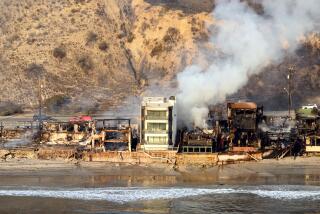Houses fueled Tahoe blaze
- Share via
It wasn’t flaming trees that ignited many of the 254 homes lost in the Lake Tahoe wildfire in June, it was other burning houses, according to a federal report released Friday.
The analysis of the 3,072-acre Angora blaze found no single factor responsible for the fire’s spread into residential neighborhoods near South Lake Tahoe.
The review instead suggested that a number of elements were at play, including unusually dry wind gusts, houses that had been built with flammable materials and long-ago commercial logging projects that had left dead treetops and limbs on the ground.
But the U.S. Forest Service report examined the effect of thinning projects conducted within and adjacent to the burn area to reduce fire risk and concluded that they had worked.
Efforts to reduce fuels were “very effective in most cases,” said Kathy Murphy, regional fuels operations manager for the Forest Service and one of the report’s authors. “They’re not designed to stop a fire. They’re designed to lower the intensity of a fire.”
The 32-page report includes several photographs of houses engulfed in flames and surrounded by trees that did not burn. A large number of homes were set ablaze by embers blown from other buildings rather than by the burning forest, the report’s authors concluded.
In some cases it appeared the houses caught fire from low-growing vegetation that had not been cleared. In other instances, embers ignited decks or shake roofs or piles of firewood stacked near the homes.
On some lots, char marks showed that the houses set the trees on fire.
The Angora blaze -- the biggest recorded wildland fire in the Lake Tahoe Basin’s history -- was caused by an untended campfire the afternoon of June 24. Driven by dry winds that gusted up to 40 mph, firefighters said, the flames did most of their damage on the first day.
Chris Sauer, the fire chief for the community of Fallen Leaf Lake, near where the blaze began, said in June that firefighters had about 30 engines mobilized during the initial two hours, all trying to protect about 300 homes. “You do the math. I was amazed about how fast some of these structures burned to the ground,” he said.
Steve Ryberg, one of the incident commanders for the Forest Service, told The Times that the presence of so many houses made the firefighting more difficult.
“You couldn’t fight the fire as much as you were trying to get people out of the way and try to protect the structures that were in the way,” he said.
The wildfire raced through acreage that had been commercially thinned in the mid-1990s to remove insect-killed trees. The Forest Service had allowed the loggers to leave logging debris scattered on the ground and the long-dead material provided fuel for the flames.
The report concluded that the fire burned just as intensely in those areas as on forest acreage that had not been thinned.
Rex Norman, spokesman for the Forest Service in the Lake Tahoe Basin, said the commercial projects “would not be done today under those types of objectives because we quite frankly have learned a great deal” since then.
“By 2000, we were introducing a lot more modern fuels treatments,” he said.
--
julie.cart@latimes.com
More to Read
Sign up for Essential California
The most important California stories and recommendations in your inbox every morning.
You may occasionally receive promotional content from the Los Angeles Times.















